March 7 –August 28, 2024
Beyond settler borders and monuments, the works in this exhibition recognize the power and importance of place; from the desire paths left over from continually wandering the same treasured areas in meadows, fields, and forests, to the objects and scents that come to represent the ways that we’ve known these spots across landscapes.
Co-curated by Robin Lynch and Kiona Callihoo Ligtvoet, Art Gallery of Grande Prairie (TREX Region 1)
March 7 –August 28, 2024
The exhibition We Are Immigrants explores the hidden hardships and legacy of early Chinese Canadian immigrants from the mid 19th century onward. It also celebrates their resilience in overcoming immense adversity and their contribution to Canada in solidifying the country’s confederacy.
Archival images, texts, historical novels, and personal interviews have collectively informed Cheung’s imagery sources and interventions. The color yellow (a stinging label yet also the seed of the artist’s identity) is reclaimed as a celebratory symbol for all Asians and is ingrained in the series to emphasize Asians as one of the earliest settlers in Canada. Chinese immigrants are an integral part of Canada’s military history and economy, and should therefore be celebrated with confidence.
Curated by Ashley Slemming, Alberta Society of Artists (TREX Region 3)
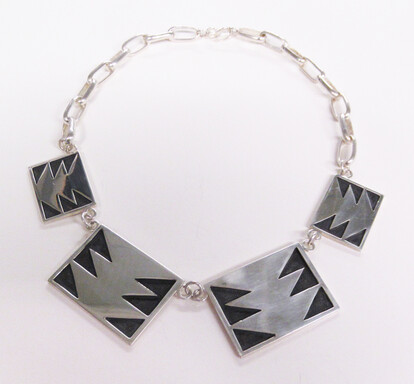
June 27, 2024 –June 18, 2025
‘More than beautiful ornamentation, adornment is a visual language expressing the joy of creativity, pride in attention to craftsmanship, and the desire to share with others. Above all, it honors oneself as well as one’s people by doing a thing well.’
Sherr Dubin, Lois. North American Indian Jewelry and Adornment; Harry N. Abrams, Inc. New York. p11,12,18
Early adornment provides a sense of knowledge about our ancestors that reflect the natural world in which they lived. The seasonal round of birth and rebirth shape our world view in a circulatory way as everything is interdependent. Through European contact and trade metal goods, cloth and glass beads were incorporated into the repertoire of the maker. Even as the use of trade materials increased, traditional styles of embellishment remained with the use of these traditional materials still being utilized to this present day, maintaining connection to ancestors, and cultural traditions. ‘Contemporary artists/artisans are keenly aware of their responsibility as guardians of traditions from which their imagery and inspiration derive.’
The exhibition ᐊᐧᐃᐧᓯᐦᒋᑲᐣ wawisihcikan-adornment features works by Elaine Alexie, Erik Lee and Carmen Miller.
Curated by MJ Belcourt and organized by the Art Gallery of Alberta (TREX Region 2). This exhibition was generously funded by Syncrude Canada Ltd.
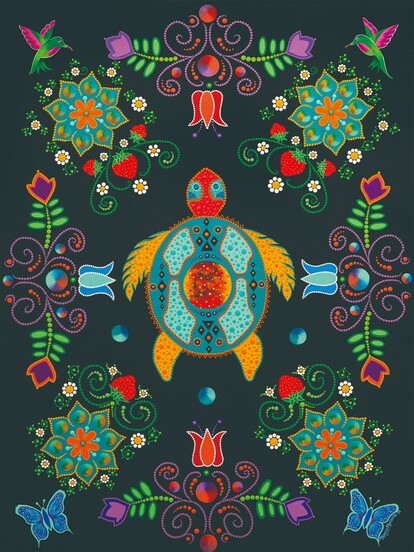
September 5, 2024 –February 27, 2025
“Atikotc eici tepwetamak, eici apitentakwak, kitci kikinowamatisowak kapena ktci mino witciiaiekki mino mantominan acitc ka tepentciketc kitci apak ka ici makopisowak, kitci nimiak tac iimikana, ka ici moseek eka maci awiakok ka ici pikopotowatc.”
“Regardless of our beliefs, what matters is to learn to commune with our spirit and with the Great Spirit to free ourselves from our suffering and to dance freely on this path that has not been burnt by the modern world.”
– Dominique (T8aminik) Rankin and Marie-Josée Tardif (co-founders of the Kina8at-Together Indigenous Organization)
The exhibition ReconciliACTIONS reminds us that reconciliation is an ongoing process, a chain of care and repair, not a one-and-done event. Decolonizing our relationships with one another and drawing new pathways of understanding based on mutual respect is empowering for all of us. Indigenous, settler, immigrant, and refugee alike all play an integral role in enacting reconciliation, and as Dominique
(T8aminik) Rankin and Marie-Josée Tardif describe in the quote above, what matters most for everyone regardless of beliefs is that we free ourselves from suffering by learning to dance on the path that has not been burnt by the modern world. What is meant by this quote? Perhaps it encourages everyone to rebuild balance and harmony into our lives together – a dance free of the shame, self-importance, greed, and noise of modern life. These modern world attributes have clouded our ability to see each other, inhibiting the repair of our relationships both individually and societally. We cannot move forward in reconciliation if we do not listen and dance with patience and vulnerability.
ReconciliACTIONS invites viewers to contemplate how they can show up with care both individually and collectively in actively carrying reconciliation forward. All persons have the agency to create ripples of change, and the Indigenous artists who are included in this exhibition are contributing to this change by educating the public and sharing their knowledge and experiences through visual forms. As you look at each artwork, consider its story, consider the artist, and consider how your own actions can be instruments of change in the ongoing process of reconciliation.
Curated by Ashley Slemming and Diana Frost, the Alberta Society of Artists (TREX Southwest).
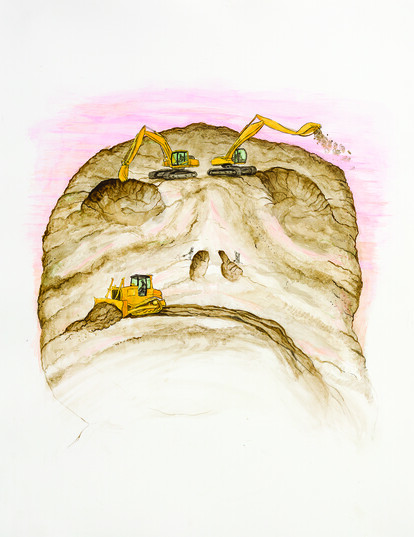
September 5, 2024 –February 27, 2025
Jude Griebel’s solo exhibition Land Eater invites reflection on human interactions with land and our impacts on the natural ecologies of the world. While the artworks conceptually explore consumption and degradation, they invite a whimsical and open-ended curiosity into how we define land and our relationships with it. There is an uncanny tension present in Griebel’s anthropomorphized landscapes, and his protesting insect sculptures, where important questions arise around who (or what?) is truly holding the proverbial ‘talking stick’ in our current conversations around climate change and consumerism – if the land is talking, what is it saying? If the various organisms we share the earth are bearing signs of resistance, what specifically is the root of their dissent?
Each of the artworks in Land Eater contemplates incredibly complicated and nuanced relationships that humans navigate related to environmental stewardship. The questions raised here allow viewers to speculate on possibilities and encourage curiosity toward what the future may hold – not just for humans, but for all natural organisms – the living earth.
Curated by Ashley Slemming, the Alberta Society of Artists (TREX Southwest).
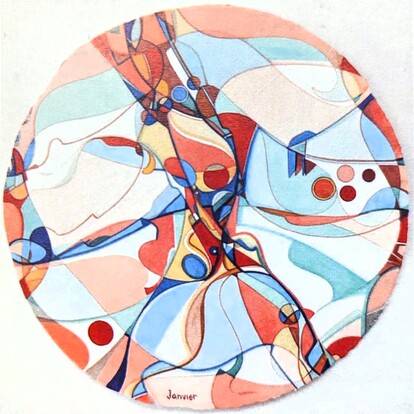
September 5, 2024 –February 27, 2025
Montageries is not a term you will find in a dictionary. Rather, it is a combination of ‘montage’ and ‘memories’ with the meanings of the two packed up into one word. One online dictionary describes a montage as being “any combination of disparate elements that forms or is felt to form a unified whole, single image, etc.” And, according to the same dictionary source, the word memories is a plural form of ‘memory’ – recalling impressions and facts, embodying remembrance, and recollections of times past.
This exhibition features a concise selection of nineteen artworks from over 8,000 objects of visual art held in the extensive permanent collection of the Alberta Foundation for the Arts (AFA). Compositionally, each of the artworks selected were created by uniting many varied components – montages of sorts – metaphorically highlighting that every artwork stands as a small part of a much larger whole (the AFA collection). Multi-layered and complex, the works included in Montageries are flashes of memory and times past that we can now take a moment to reflect on and remember as we commemorate the fiftieth anniversary of the Alberta Foundation for the Arts’ permanent collection in the year 2022.
On September 29, 1972, the collection was officially legislated. From that date on, the AFA Art Collection has annually acquired artworks from Alberta’s visual artists and is a continually evolving exemplification of the history, development, and achievements of our provincial visual arts community. In the very first annual report from the Alberta Art Foundation (now renamed the Alberta Foundation for the Arts), Chairman W.B. McMullen wrote, “I trust that the nucleus has now been established for a collection which will continue to grow in every way.” There is certainly evidence of growth within the foundation as we look back on the past fifty years, and there is much to look forward to as we look ahead to the next fifty years.
Some key visual metaphors present themselves throughout the exhibition which hint broadly toward expansions, multiplicities, and fragmentations. Whether intentional or not, John Hall’s woodcut Untitled (n.d.) and Robert Dmytruk’s mixed media painting Touch S. B. W. S. D. W. C (2003) visually nod towards the idea of an ever-growing nucleus. Meanwhile Brenda Jones-Smith’s monoprint Place to Gather (2001) and Chris Cran’s Cleveland Portrait #1 (2013) use pixels or dots of paint to montage formal elements together into meaningful compositions. Close contemplation while viewing the artworks in Montageries reveal glimpses of Alberta’s art history but more importantly will encourage viewers to consider the ‘bigger picture’ of what each artwork might represent within the context of a fifty-years-young permanent art collection.
Curated by Ashley Slemming, the Alberta Society of Artists (TREX Southwest).
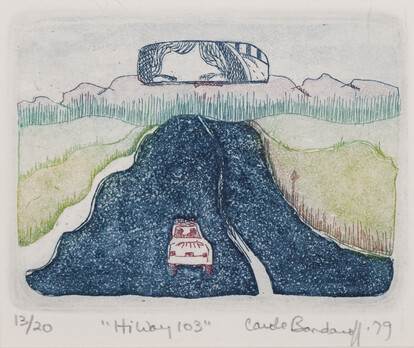
September 5, 2024 –February 27, 2025
All the Time in the World presents a collection of artworks that chronicle the story of an imaginary summer road trip. Borrowed from the Alberta Foundation for the Art’s permanent collection, audiences are sure to encounter familiar sites and scenes in this broad array of artworks: a 1980’s photograph of RVs parked in the picturesque Tunnel Mountain campsite; a woodcut image of bathers enjoying the upper hot springs in Banff. Journeying on and on, we encounter the Bow River, an icon of our province’s landscape which begins deep within the Rocky Mountains and winds its way into the foothills and onto the prairies. A painting of man and his two children fishing on the Bow, a photograph of a cowboy posed in front of glacial Lake Minnewanka, this exhibition longs for the easy days of summer spent driving endless roadways, sleeping in pop-up tents and marveling at a diversity of flora and fauna. This imaginary road trip offers a respite from the busy modern life and hopes to act as a reminder that there is more than enough time to breathe in all the goodness of the world.
Curated by Genevieve Farrell, Esplanade Arts & heritage Centre (TREX Southeast)
